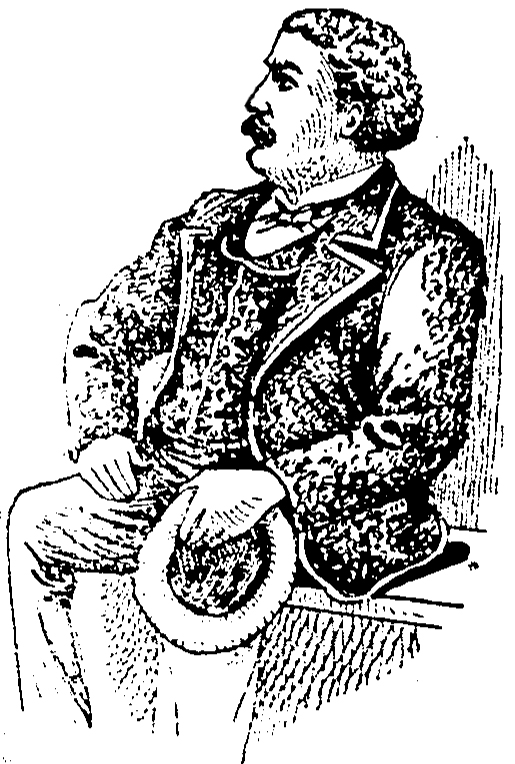For a while, It looked like Ed Witz was a hero. The scrappy son of a Sixth-Street fish merchant, amateur detective Ed blew the lid off one of Cincinnati’s most notorious murders. Unfortunately, there was another chapter to Ed’s story.
Late in September 1891 a dead man was discovered propped up against the wall behind 253 West Sixth Street, a low dive run by a dangerous character named Nick Delmore. Even though Delmore had a shady reputation – it was rumored that he was in the Mafia – no one connected the body to his saloon. In fact, no one seemed to know the identity of the dead man at all.
Eventually, after the body cooled in the morgue for several days, he was identified as John Hicks, a farmer from Mt. Healthy. The morgue recorded that he died from consumption. A coroner’s inquest resulted in a determination that heart disease was the cause of death.

From Cincinnati Enquirer 31 January 1892 Image extracted from microfilm by Greg Hand
Some weeks before Hicks died, Ed Witz, around 30 years old, entered Delmore’s saloon, waving what was then called a “flash roll,” an apparently large roll of dollar bills, but in very small denominations. Witz worked in his father’s fish market next door. He had just been paid and wanted to look like a high roller. According to the Cincinnati Enquirer [30 January 1892]:
“After he had taken one or two drinks in Delmore’s Witz began to feel sick. He was given a seat in the back room. That was the last he remembered until he awoke to find himself in Belle Riley’s house of ill fame on George Street.”
Witz was examined by a doctor, who announced that he was not inebriated, but drugged. He was also broke. All of his money had been stolen.
Witz swore revenge. The newspapers regaled their readers with the saga of his dogged search for clues. As part of his investigation, Witz wooed a young lady named Josie Bruce. Josie worked in Delmore’s saloon where she encouraged men to buy lots of drinks while she sipped sarsaparilla. Witz installed Josie in an apartment and paid her bills. Over the course of months, he got Josie to tell a little more, and then a little more, bit by bit, until one night, after a few drinks, she spilled the whole story.
According to Josie Bruce, Nick Delmore regularly drugged and robbed any customers who looked like they might have some money. Delmore kept a stash of morphine behind the bar and laced his drinks with it. When the customer nodded off, he emptied their pockets and threw them, apparently drunk, onto the street for the police to haul in on public inebriation charges.
John Hicks didn’t follow the plan. He was in bad health to begin with and the morphine sent him into a stupor. Hicks began drinking Delmore’s drugged wine at 9:00 a.m. and was nearly unconscious before noon. Delmore sent him upstairs to lie down. A few hours later, one of Delmore’s prostitutes came downstairs with bad news:
“’That old farmer’s in a bad fix. I couldn’t wake him and Johnny [Bryan, the bartender] beat him and shook him and he won’t wake up. He acts like he was going to die and has turned an awful color.’”
Hicks did die, a little after midnight, and Nick Delmore and Josie Bruce carried his body into the alley behind the saloon where police discovered it next morning.
Once Witz reconstructed Hicks’ murder, he took his information to the police and they immediately arrested everyone involved. Although the case claimed front-page headlines for days, and although the suspects all testified against each other, everyone was acquitted. Despite his legal innocence, the Cincinnati Police informed Nick Delmore that he was no longer welcome to live or do business in Cincinnati.

From Cincinnati Enquirer 31 January 1892 Image extracted from microfilm by Greg Hand

From Cincinnati Enquirer 31 January 1892 Image extracted from microfilm by Greg Hand
Two months later, Ed Witz, the doughty fishmonger detective, was himself in court. This time, he was the defendant. It appears that Ed Witz was a known “fence,” buying up and selling stolen property while helping burglars locate vulnerable stores to rob. Witz was also a police informant of long standing. While the newspapers touted his investigative skills, the cops, according to the Cincinnati Post [16 April 1892] chalked up Witz’s pursuit of Delmore to just another snitch:
“’A “snitch” will fall some time,’ was the remark of a detective at Police Headquarters, when Detective Toker walked into the office of Chief Deitsch, having in charge the notorious Ed Witz, who figured as the chief witness in the Delmore ‘house of horrors’ affair.”
It appears that Witz was well known to police, who recruited him as an informant after they busted him for producing counterfeit coins. Convicted on charges of receiving stolen property, Witz was shipped up to the state penitentiary in Columbus. While incarcerated, Witz was put to work in the prison chair factory, where he lost part of his hand in an accident.
That injury did not prevent Witz from engaging in a bar fight after his release in 1898. Witz slashed his opponent with a knife. His victim’s brother was a cop and Witz wisely split town for three years, eventually being arrested in Louisville and hauled back to face attempted murder charges.
The one-time sleuth spent a lot of his remaining time in prison.
This article was reposted with permission from Greg Hand, editor of Cincinnati Curiosities.





Facebook Comments